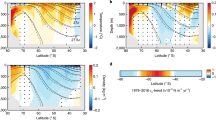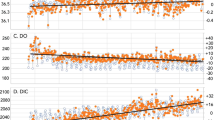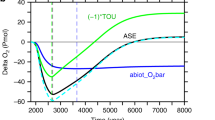Abstract
Ocean models predict a decline in the dissolved oxygen inventory of the global ocean of one to seven per cent by the year 2100, caused by a combination of a warming-induced decline in oxygen solubility and reduced ventilation of the deep ocean1,2. It is thought that such a decline in the oceanic oxygen content could affect ocean nutrient cycles and the marine habitat, with potentially detrimental consequences for fisheries and coastal economies3,4,5,6. Regional observational data indicate a continuous decrease in oceanic dissolved oxygen concentrations in most regions of the global ocean1,7,8,9,10, with an increase reported in a few limited areas, varying by study1,10. Prior work attempting to resolve variations in dissolved oxygen concentrations at the global scale reported a global oxygen loss of 550 ± 130 teramoles (1012 mol) per decade between 100 and 1,000 metres depth based on a comparison of data from the 1970s and 1990s10. Here we provide a quantitative assessment of the entire ocean oxygen inventory by analysing dissolved oxygen and supporting data for the complete oceanic water column over the past 50 years. We find that the global oceanic oxygen content of 227.4 ± 1.1 petamoles (1015 mol) has decreased by more than two per cent (4.8 ± 2.1 petamoles) since 1960, with large variations in oxygen loss in different ocean basins and at different depths. We suggest that changes in the upper water column are mostly due to a warming-induced decrease in solubility and biological consumption. Changes in the deeper ocean may have their origin in basin-scale multi-decadal variability, oceanic overturning slow-down and a potential increase in biological consumption11,12.
This is a preview of subscription content, access via your institution
Access options
Access Nature and 54 other Nature Portfolio journals
Get Nature+, our best-value online-access subscription
$29.99 / 30 days
cancel any time
Subscribe to this journal
Receive 51 print issues and online access
$199.00 per year
only $3.90 per issue
Buy this article
- Purchase on Springer Link
- Instant access to full article PDF
Prices may be subject to local taxes which are calculated during checkout



Similar content being viewed by others
References
Keeling, R. F., Körtzinger, A. & Gruber, N. Ocean deoxygenation in a warming world. Annu. Rev. Mar. Sci. 2, 199–229 (2010)
Long, M. C., Deutsch, C. A. & Ito, T. Finding forced trends in oceanic oxygen. Glob. Biogeochem. Cycles 30, 381–397 (2016)
Diaz, R. J. & Rosenberg, R. Spreading dead zones and consequences for marine ecosystems. Science 321, 926–929 (2008)
Stramma, L. et al. Expansion of oxygen minimum zones may reduce available habitat for tropical pelagic fishes. Nat. Clim. Change 2, 33–37 (2011)
Vaquer-Sunyer, R. & Duarte, C. M. Thresholds of hypoxia for marine biodiversity. Proc. Natl Acad. Sci. USA 105, 15452–15457 (2008)
Worm, B. Global patterns of predator diversity in the open oceans. Science 309, 1365–1369 (2005)
Stramma, L., Johnson, G. C., Sprintall, J. & Mohrholz, V. Expanding oxygen-minimum zones in the tropical oceans. Science 320, 655–658 (2008)
Whitney, F. A., Freeland, H. J. & Robert, M. Persistently declining oxygen levels in the interior waters of the eastern subarctic Pacific. Prog. Oceanogr. 75, 179–199 (2007)
Bograd, S. J. et al. Oxygen declines and the shoaling of the hypoxic boundary in the California Current. Geophys. Res. Lett. 35, L12607 (2008)
Helm, K. P., Bindoff, N. L. & Church, J. A. Observed decreases in oxygen content of the global ocean. Geophys. Res. Lett. 38, L23602 (2011)
Broecker, W. S., Sutherland, S. & Peng, T.-H. A possible 20th-century slowdown of Southern Ocean Deep Water formation. Science 286, 1132–1135 (1999)
Keller, D. P., Kriest, I., Koeve, W. & Oschlies, A. Southern Ocean biological impacts on global ocean oxygen. Geophys. Res. Lett. 43, 6469–6477 (2016)
Bopp, L., Le Quéré, C., Heimann, M., Manning, A. C. & Monfray, P. Climate-induced oceanic oxygen fluxes: implications for the contemporary carbon budget. Glob. Biogeochem. Cycles 16, http://dx.doi.org/10.1029/2001GB001445 (2002)
Deutsch, C., Brix, H., Ito, T., Frenzel, H. & Thompson, L. Climate-forced variability of ocean hypoxia. Science 333, 336–339 (2011)
Keeling, R. F. & García, H. E. The change in oceanic O2 inventory associated with recent global warming. Proc. Natl Acad. Sci. USA 99, 7848–7853 (2002)
Stendardo, I. & Gruber, N. Oxygen trends over five decades in the North Atlantic. J. Geophys. Res. 117, C11004 (2012)
Deutsch, C. A., Emerson, S. & Thompson, L. Fingerprints of climate change in North Pacific oxygen. Geophys. Res. Lett. 32, L16604, http://dx.doi.org/10.1029/2005GL023190 (2005)
Schmidtko, S., Johnson, G. C. & Lyman, J. M. MIMOC: A global monthly isopycnal upper-ocean climatology with mixed layers. J. Geophys. Res. Oceans 118, 1658–1672 (2013)
Schmidtko, S., Heywood, K. J., Thompson, A. F. & Aoki, S. Multidecadal warming of Antarctic waters. Science 346, 1227–1231 (2014)
Frölicher, T. L., Joos, F., Plattner, G. K., Steinacher, M. & Doney, S. C. Natural variability and anthropogenic trends in oceanic oxygen in a coupled carbon cycle-climate model ensemble. Glob. Biogeochem. Cycles 23, GB1003, http://dx.doi.org/10.1029/2008GB003316 (2009)
Bianchi, D., Galbraith, E. D., Carozza, D. A., Mislan, K. A. S. & Stock, C. A. Intensification of open-ocean oxygen depletion by vertically migrating animals. Nat. Geosci. 6, 545–548 (2013)
Wyrtki, K. The thermohaline circulation in relation to the general circulation in the oceans. Deep-Sea Res. 8, 39–64 (1961)
Cheung, W. W. L. et al. Shrinking of fishes exacerbates impacts of global ocean changes on marine ecosystems. Nat. Clim. Change 3, 254–258 (2012)
Codispoti, L. A. Interesting times for marine N2O. Science 327, 1339–1340 (2010)
Santoro, A. E., Buchwald, C., McIlvin, M. R. & Casciotti, K. L. Isotopic signature of N2O produced by marine ammonia-oxidizing Archaea. Science 333, 1282–1285 (2011)
Kwon, E. Y., Deutsch, C. A., Xie, S.-P., Schmidtko, S. & Cho, Y.-K. The North Pacific Oxygen uptake rates over the past half century. J. Clim. 29, 61–76 (2016)
Watanabe, Y. W. et al. Probability of a reduction in the formation rate of the subsurface water in the North Pacific during the 1980s and 1990s. Geophys. Res. Lett. 28, 3289–3292 (2001)
Purkey, S. G. & Johnson, G. C. Global contraction of Antarctic bottom water between the 1980s and 2000s. J. Clim. 25, 5830–5844 (2012)
Kwok, R. & Rothrock, D. A. Decline in Arctic sea ice thickness from submarine and ICESat records: 1958–2008. Geophys. Res. Lett. 36, L15501, http://dx.doi.org/10.1029/2009GL039035 (2009)
Morison, J. et al. Changing Arctic Ocean freshwater pathways. Nature 481, 66–70 (2012)
Biastoch, A., Böning, C. W., Getzlaff, J., Molines, J.-M. & Madec, G. Causes of interannual–decadal variability in the meridional overturning circulation of the midlatitude North Atlantic Ocean. J. Clim. 21, 6599–6615 (2008)
Cocco, V. et al. Oxygen and indicators of stress for marine life in multi-model global warming projections. Biogeosciences 10, 1849–1868 (2013)
Carpenter, J. H. The accuracy of the Winkler method for dissolved oxygen analysis. Limnol. Oceanogr. 10, 135–140 (1965)
Wilcock, R. J., Stevenson, C. D. & Roberts, C. A. An interlaboratory study of dissolved oxygen in water. Water Res. 15, 321–325 (1981)
Knapp, G. P., Stalcup, M. C. & Stanley, R. J. Iodine losses during Winkler titrations. Deep-Sea Res. A 38, 121–128 (1991)
Amante, C. & Eakins, B. W. ETOPO1 1 Arc-minute Global Relief Model: Procedures, Data Sources and Analysis. NOAA Technical Memorandum NESDIS NGDC-24, http://dx.doi.org/10.7289/V5C8276M (NOAA, National Geophysical Data Center, 2009)
Oceanic Niño Index (ONI) (NOAA Climate Prediction Center); available at http://www.cpc.ncep.noaa.gov/products/analysis_monitoring/ensostuff/ensoyears.shtml (accessed 24 March 2014)
Cleveland, W. S. Robust locally weighted regression and smoothing scatterplots. J. Am. Stat. Assoc. 74, 829–836 (1979)
Khatiwala, S., Primeau, F. & Hall, T. Reconstruction of the history of anthropogenic CO2 concentrations in the ocean. Nature 462, 346–349 (2009)
Keeling, R. F. & Severinghaus, J. P. in The Carbon Cycle (eds Wigley, T. M. L. & Schimel, D. ) 134–140 (Global Change Institute, Proceedings on the Carbon Cycle, Cambridge Univ. Press, 2000)
Keeling, R. F. & Manning, A. C. in Treatise on Geochemistry 2nd edn (eds Turekian, K. & Holland, H. ) 385–404 (Elsevier, 2014)
Acknowledgements
S.S. was supported by the German Federal Ministry of Education and Research project MIKLIP, and L.S. and M.V. by the German Research Foundation (DFG) as part of research project SFB-754. We thank R. Keeling for providing expertise on chemical processes of oxygen measurements and calculating impacts on carbon budgeting.
Author information
Authors and Affiliations
Contributions
S.S. designed the experiment and did the computations and data analysis; L.S. and S.S. evaluated the analysis; and M.V. provided expertise on ocean ventilation and computations. All authors discussed the results and wrote the manuscript.
Corresponding author
Ethics declarations
Competing interests
The authors declare no competing financial interests.
Additional information
Reviewer Information Nature thanks S. Doney, D. Gilbert and the other anonymous reviewer(s) for their contribution to the peer review of this work.
Extended data figures and tables
Extended Data Figure 1 Dissolved oxygen and apparent oxygen utilization changes per decade since 1960.
a, Change of dissolved oxygen (DO) per square metre per decade (in units of percentage of local dissolved oxygen); these data are similar to those in Fig. 1. b, Change of apparent oxygen utilization (AOU) in units of mol per square metre per decade.
Extended Data Figure 2 Oxygen solubility changes.
a–c, Zonal upper 2,500 m mean oxygen solubility changes in the Atlantic (a), Indian (b) and Pacific (c) oceans. No substantial changes are observed below 1,000 m. Contour lines represent oxygen concentrations at 20 μmol kg−1 and every 30 μmol kg−1.
Extended Data Figure 3 Temperature and salinity changes.
a–f, Zonal mean temperature (T; a–c) and salinity (S; d–f) changes in the Atlantic (top row), Indian (middle row) and Pacific (bottom row) oceans per decade. Data locations and handling are identical to those used for the oxygen computation and for the results in Extended Data Fig. 1. This is only a small subset of data available for global temperature and salinity trend computations. Contour lines represent the mean fields. Observed trends are similar to trends described in the literature and thus confirm that no artificial trend is created because of sparse or irregular data locations or through the mapping method. Distortions in the North Atlantic around 40° N are due to the Mediterranean Sea, which creates a discontinuity in the zonal means.
Extended Data Figure 4 Oxygen concentration and changes.
a–f, Zonal mean oxygen concentrations in the Atlantic, Indian and Pacific oceans (a–c, respectively), and respective changes in oxygen concentration per decade (d–f). Contour lines are at 20 μmol kg−1 and every 30 μmol kg−1.
Extended Data Figure 5 Oxygen profile data coverage since 1900.
Blue indicates locations of oxygen profiles over 5-year data intervals, given at the top of each panel.
Extended Data Figure 6 Time span of observations and time of last observation in data sets.
a–j, Time span in years is colour coded (key at right of each panel); each panel shows results for the indicated depth layer. k–t, Year of last observation of data for each grid point mean state and trend computation is colour coded; each panel shows the results for a particular depth layer.
Extended Data Figure 7 Expected oxygen loss distribution from artificial bias.
a–c, Zonal mean changes in dissolved oxygen (colour key at right) of an induced systematic bias of 0.5% for historic measurements (Methods) for Atlantic (a), Indian (b) and Pacific (c) oceans. Note the different order of magnitude of colour scales compared to Extended Data Fig. 4. Solid lines represent the mean oxygen field, as in Extended Data Fig. 4.
Extended Data Figure 8 Trend of zonal oxygen loss using reduced data sets.
a–f, Change in dissolved oxygen of reduced oxygen data distributions for 20,000 profiles per decade (a–c) and 30,000 profiles per decade (d–f), validating the robustness of the mapping with ‘strongly reduced’ and ‘reduced’ data sets in comparison with the full data set as presented in this Letter (see Methods for details). The global mean trends related to these maps are 946 ± 526 Tmol per decade (a–c) and 988 ± 459 Tmol per decade (d–f). Solid lines represent the mean oxygen field, as in Extended Data Fig. 4.
Rights and permissions
About this article
Cite this article
Schmidtko, S., Stramma, L. & Visbeck, M. Decline in global oceanic oxygen content during the past five decades. Nature 542, 335–339 (2017). https://doi.org/10.1038/nature21399
Received:
Accepted:
Published:
Issue Date:
DOI: https://doi.org/10.1038/nature21399
This article is cited by
-
Cross-shore transport and eddies promote large scale response to urban eutrophication
Scientific Reports (2024)
-
Hydrological cycle amplification reshapes warming-driven oxygen loss in the Atlantic Ocean
Nature Climate Change (2024)
-
Large igneous province activity drives oceanic anoxic event 2 environmental change across eastern Asia
Communications Earth & Environment (2024)
-
Natural warming differentiates communities and increases diversity in deep-sea Ridge Flank Hydrothermal Systems
Communications Biology (2024)
-
Highly active fish in low oxygen environments: vertical movements and behavioural responses of bigeye and yellowfin tunas to oxygen minimum zones in the eastern Pacific Ocean
Marine Biology (2024)
Comments
By submitting a comment you agree to abide by our Terms and Community Guidelines. If you find something abusive or that does not comply with our terms or guidelines please flag it as inappropriate.



